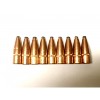I purchased 1000 150 grain Federal Fusion bullets in 308, all pulled. I previously shot around 200 130 grain Federal Fusion bullets (pulled) in two 270 Winchesters and they shot well. I can say the 277 Federal Fusion bullets would hold the ten ring out to 300 yards, but I have no idea how these bullets perform on game.
So, what is the experience of those who have used Federal Fusion bullets on game? Did they perform well, as expected.....?
I doubt I would shoot anything larger than deer, but you never know.
So, what is the experience of those who have used Federal Fusion bullets on game? Did they perform well, as expected.....?
I doubt I would shoot anything larger than deer, but you never know.




